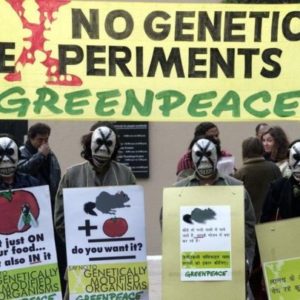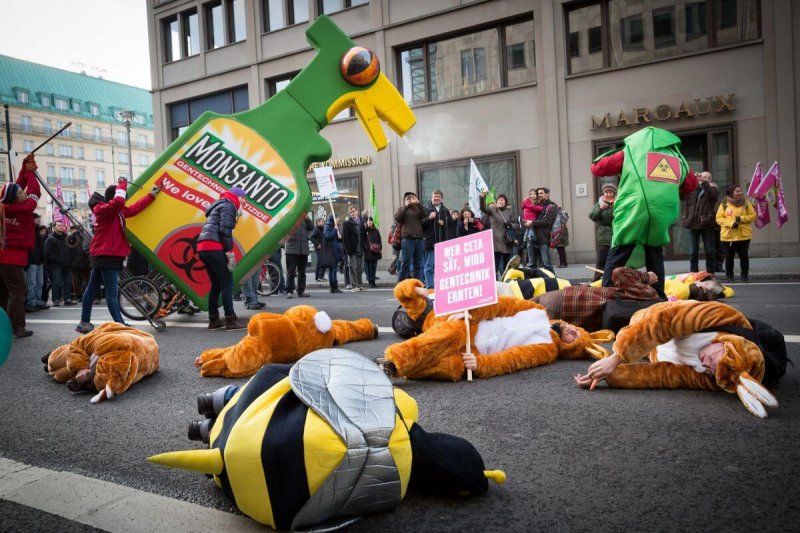Glyphosate has probably been exposed to more scrutiny and debate than any other pesticide since the insecticide DDT, the dangers of which were brought to public attention by Rachel Carson in her classic 1962 book Silent Spring. Evaluations of the safety of herbicides depend, in part, on the proper application of statistical methods. Unfortunately, the glyphosate debate is littered with ignorance of available statistics, conceptual confusion and misuse of statistical methods.
Glyphosate use
Both the UK and US have quite good time series data on pesticide use. Despite an EU directive in 2009 to establish a framework for Community action to achieve the sustainable use of pesticides, which includes a section on collecting statistics, EU-wide statistics remain patchy and based on overall pesticide sales and not on pesticide use by farmers and others. The UN Food and Agriculture Organisation also bemoans the absence of pesticide use statistics from many countries. The omission is particularly noteworthy in the cases of Argentina and Brazil where Roundup Ready crops, soy especially, are so widely grown.
The UK and US data show that farmers have applied more and more glyphosate to their main crops over the last twenty five years. And it is likely that nearly all farmers in developed countries control weeds chemically and are unlikely to stop doing so. But applying more glyphosate does not necessarily mean increasing the chemical burden when controlling weeds. In the UK, overall weight of herbicides used on arable crops as a whole, and for cereals, has in fact declined since 1990. In the US on the other hand, herbicide use has increased for wheat. Herbicides are not, however, homogeneous; they vary in their environmental impact and any assessment of their effects needs to take this into account.
Glyphosate safety
 The controversy about the safety of glyphosate was rekindled by the International Agency for Research on Cancer (IARC). In March 2015, IARC issued a class 2A classification to glyphosate: ‘probably carcinogenic to humans’. This classification has received considerable critical attention from researchers and commentators as well as a lot of publicity in the media.
The controversy about the safety of glyphosate was rekindled by the International Agency for Research on Cancer (IARC). In March 2015, IARC issued a class 2A classification to glyphosate: ‘probably carcinogenic to humans’. This classification has received considerable critical attention from researchers and commentators as well as a lot of publicity in the media.
IARC, IARC scientists and study itself is embroiled in controversy. In the past week, it’s been revealed that the scientist who guided the IARC process is on the pay of ambulance-chasing litigators who are pressing class action suit claiming that glyphosate causes cancer–a claim that rests almost entirely on the credibility of IARC’s determination. Christopher Portier has been paid at least $160,000 as a consultant to the litigators–and has for many months publicly concealed his conflict of interest, including in presentations to European parliamentarians who are charged with deciding whether to extend glyphosate’s license in Europe.
The IARC controversy took another troubling turn last week when a Reuters investigation revealed that in at least 10 instances, the wording on IARC’s draft report was changed from findings of ‘non-carcinogenic’. In each case, a negative conclusion about glyphosate leading to tumors was either deleted or replaced with a neutral or positive one. Reuters was unable to determine who made the changes before the final report was issued.
There are two main strands to the criticisms of the substance IARC’s findings. The first is that, even in their own terms, IARC did not always satisfactorily assess the evidential value of the many studies available to them. The other, and arguably more germane strand relates to the important but subtle distinction between hazard and risk. ‘Risk’ takes the dose into account, ‘hazard’ does not. The IARC approach leads them to assess the hazards of different aspects of life. Thus, for example, sunlight is classified by IARC as a class 1 carcinogen: ‘carcinogenic to humans’ (and thus more dangerous than glyphosate). Of course, prolonged exposure to sunlight can be dangerous but some exposure is necessary in terms of vitamin D intake. A similar issue arises with glyphosate – it could be dangerous at extreme doses but the evidence from regulatory bodies suggests that it is not dangerous if used in accordance with herbicide manufacturers’ instructions about dilution and protection. In other words, the evidence indicates that the risks from glyphosate are small once typical exposures are taken into account. This does raise the question of whether the IARC approach is fit for purpose given the media’s propensity to seize on cancer scares whenever they can.
The distinction between hazard and risk has been clearly and widely spelt out by scientists since the IARC report but is wilfully ignored by some Green groups. Thus we find Greenpeace proclaiming “Monsanto’s super popular weed killer, Roundup, probably causes cancer!” as part of a campaign to have it banned. Apart from the misrepresentation of risk, what this ignores is (i) glyphosate is found in many products; (ii) many farmers in the developed world use herbicides and, if glyphosate were banned, they are likely to turn to other herbicides that are arguably more deleterious to the environment; (iii) farmers might rely more on ploughing and other practices that also have undesirable consequences in terms of carbon release and (iv) farmers in poorer countries might be discouraged from using such a relatively benign herbicide and so lose a much needed opportunity, ideally within the context of integrated weed management, to increase crop yields.
Another difficulty with the IARC classification is that it has led to disputes between them and regulatory bodies in Europe and North America. In Europe, the European Food Safety Authority (EFSA) is the body responsible for assessing the health risks from pesticides. They appoint an organisation from one of the EU member states to carry out the assessment and, for glyphosate, this was the German BfR (Federal Institute for Risk Assessment). BfR’s focus was on risk rather than hazard and EFSA concluded that ‘glyphosate is unlikely to pose a carcinogenic hazard to humans and the evidence does not support classification with regard to its carcinogenic potential according to Regulation (EC) No 1272/2008.’ Moreover, even the European Chemicals Agency – which assesses hazard rather than risk – concluded that the evidence did not meet the criteria for classifying glyphosate as a carcinogen. In the US, the Environmental Protection Agency (EPA) concluded that the category with the strongest support is “not likely to be carcinogenic to humans at doses relevant to human health risk assessment”.
Scientific investigations
There have been many scientific papers about the effects of glyphosate on human health; the 2016 IARC report contained references to over150 papers with glyphosate or Roundup in the title. Moreover, there are a number of reports on glyphosate residues in food, breast milk and urine, usually funded by pressure groups (Moms Across America; Food Democracy Now), which have rather unsound scientific foundations, are light on procedural and methodological details, and which seem designed as much to scare people as to inform them.
 There is, however, one research group – CRIIGEN at the University of Caen, France with Professor Gilles-Eric Séralini as its lead researcher – which has been especially active in this field over the last decade.
There is, however, one research group – CRIIGEN at the University of Caen, France with Professor Gilles-Eric Séralini as its lead researcher – which has been especially active in this field over the last decade.
There are many statistical deficiencies in the CRIIGEN papers, but to summarise: they ignore fundamental issues of statistical inference including the importance of clustering within experimental animals, they are not transparent in their discussion of selection and missing data, they gloss over issues of dose response relations and they use obscure statistical methods to obfuscate rather than to illuminate. Despite these damaging frailties, Séralini’s research is still widely and positively referenced by Green groups and politicians, e.g. Corinne Lepage, former French Minister of the Environment.
Conclusion
Although the current evidence against glyphosate, especially its effects on human health, is weak, there are issues that need to be kept under review and where more investigations are warranted. Concerns about the emergence of weeds resistant to glyphosate are well founded although resistance to any herbicide will occur if it is over-used. And pesticides of all kinds, including those used by organic growers, carry an element of risk to the wider environment, risks which need to be monitored and revised as new evidence emerges. Moreover, there is understandable suspicion about the motives of large agri-business companies in terms of their marketing strategies and the extent to which they suppress evidence about the environmental effects of their products. There can be no doubt that Roundup, in combination with RR crops like corn and soybeans, has generated enormous profits for Monsanto. And, if the proposed takeover of Monsanto by the German chemical giant Bayer goes ahead, then there is a justifiable concern that the world’s food supplies will, indirectly, be concentrated in just a few global corporations.
Unfortunately Green politicians, especially the Green group in the European parliament, and international Green pressure groups are too easily drawn to their Great Satans, Monsanto and GE crops, instead of assessing the status of the evidence against glyphosate and of assessing what the economic and social costs would be if it were banned. There are arguably much more important agricultural practices that need to be addressed if a world of nine or more billion people is to feed itself – land degradation, devoting so much land to growing crops just to feed animals, and developing crops that are robust to the effects of climate change being just some of these. A particularly egregious example of misplaced effort was the recent “Monsanto Tribunal”, essentially a show trial in which Monsanto was accused of ecocide, where the judges were appointed by the prosecution, where parts of the evidence consisted of dubious anecdotes by people who claimed to have become ill after being exposed to glyphosate, and where no cross-examination by the defence was allowed. The published judgment shows a dismaying lack of understanding of the distinction between hazard and risk. Professor Séralini and Corinne Lepage were both members of the steering group for this event. The scientists and lawyers who got involved in it could surely have found better uses of their time, and the Green groups who funded it might have used their money more wisely.
We need good data, and well-designed and analysed studies on the use and effects of herbicides and other pesticides. And these data should be produced and made public in a transparent way. This applies as much to the multinational companies as it does to academic researchers. We also need a more honest debate about the costs and benefits of herbicides like glyphosate and to stem the tide of misinformation. At a time of such pressing environmental concerns, and when the value of evidence and expertise is constantly being undermined, Green groups and journalists might reasonably be expected to critically examine their own roles in how public debates of this kind are conducted.
This piece is based on a longer article that came out in the journal Radical Statistics in September 2017. Copies of the article are available on request.
Ian Plewis is an emeritus professor of social statistics at University of Manchester.































